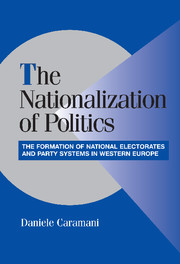 The Nationalization of Politics
The Nationalization of Politics Book contents
- Frontmatter
- Contents
- List of Tables
- List of Figures
- Abbreviations and Symbols
- Preface and Acknowledgments
- INTRODUCTION: HOMOGENEITY AND DIVERSITY IN EUROPE
- Part I Framework
- Part II Evidence
- 3 TIME AND SPACE: EVIDENCE FROM THE HISTORICAL COMPARISON
- 4 TYPES OF TERRITORIAL CONFIGURATIONS: NATIONAL VARIATIONS
- 5 THE COMPARATIVE STUDY OF CLEAVAGES AND PARTY FAMILIES
- Part III Toward an Explanation
- CONCLUSION: FROM TERRITORIAL TO FUNCTIONAL POLITICS
- Appendix 1 Party Codes
- Appendix 2 Territorial Units
- Appendix 3 Computations
- Appendix 4 Country Specificities
- Appendix 5 Sources
- References
- Index
- Cambridge Studies in Comparative Politics
4 - TYPES OF TERRITORIAL CONFIGURATIONS: NATIONAL VARIATIONS
Published online by Cambridge University Press: 02 December 2009
- Frontmatter
- Contents
- List of Tables
- List of Figures
- Abbreviations and Symbols
- Preface and Acknowledgments
- INTRODUCTION: HOMOGENEITY AND DIVERSITY IN EUROPE
- Part I Framework
- Part II Evidence
- 3 TIME AND SPACE: EVIDENCE FROM THE HISTORICAL COMPARISON
- 4 TYPES OF TERRITORIAL CONFIGURATIONS: NATIONAL VARIATIONS
- 5 THE COMPARATIVE STUDY OF CLEAVAGES AND PARTY FAMILIES
- Part III Toward an Explanation
- CONCLUSION: FROM TERRITORIAL TO FUNCTIONAL POLITICS
- Appendix 1 Party Codes
- Appendix 2 Territorial Units
- Appendix 3 Computations
- Appendix 4 Country Specificities
- Appendix 5 Sources
- References
- Index
- Cambridge Studies in Comparative Politics
Summary
This chapter compares the territorial configurations of electoral support for the political parties of each country and highlights their specificities, the final aim being the identification of types of territorial configurations on the basis of two dimensions: (1) How regionalized is the support for the main parties of a system? (2) What is the impact of regionalist parties, that is, parties specifically created for territorial defense on the basis of linguistic, religious, or economic distinctiveness? To do this, the level of analysis shifts from party systems to single parties. A series of tables on all countries (limited to the post–World War II period) display the values of homogeneity for each political party (based on measures controlling for their size). Diachronically, the analysis describes the historical evolution through time of the levels of nationalization for all major parties.
This country-by-country analysis cannot incorporate – in the frame of a broad comparative and historical work – the large amount of literature produced in each national system on the geography of the vote. Instead, the analysis presented here is based on a great deal of new data on the territoriality of each party requiring a first défrichement and a systematic exploration. In Figure 4.1 – placed in the middle of this chapter since it includes graphs for all countries – to improve the visibility of the graphs, only major parties have been considered as well as parties significantly affecting the territorial configuration of the vote in a given system (e.g., green parties for which the evolution over time is limited have been omitted).
- Type
- Chapter
- Information
- The Nationalization of PoliticsThe Formation of National Electorates and Party Systems in Western Europe, pp. 111 - 153Publisher: Cambridge University PressPrint publication year: 2004


